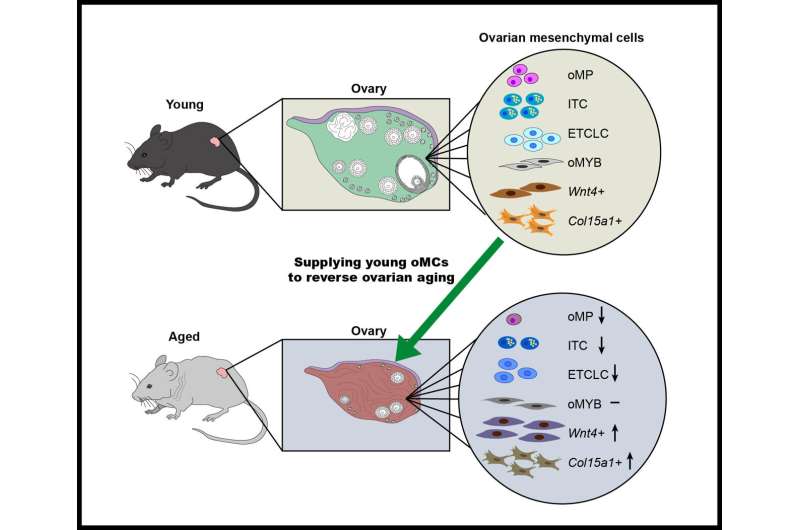This article has been reviewed according to Science X's editorial process and policies. Editors have highlighted the following attributes while ensuring the content's credibility:
fact-checked
peer-reviewed publication
trusted source
proofread
Ovarian mesenchymal cells, a group of non-germ cells, regulate the aging of female reproduction

The ovary is the female gonad responsible for producing eggs to create new life, and it is also the primary aging organ in women. As a heterogeneous organ, the ovary is composed of various types of cells, including germ cells and somatic cells. While most ovarian research focuses on the development of oocytes and surrounding granulosa cells, little is known about the cellular composition of ovarian stroma cells.
However, a growing body of evidence suggests that ovarian stroma cells play a crucial role in regulating fertility and ovarian aging.
In this study, researchers provided a single-cell transcriptomic landscape of mouse ovarian mesenchymal cells (oMCs) and analyzed the cellular and molecular changes related to ovarian stroma cell aging. They identified a group of ovarian mesenchymal progenitors (oMPs) and found that these oMPs construct other significant endocrine cell populations, such as theca cells. Furthermore, in-depth investigations revealed that the decline in the quality of oMCs was a crucial cause of ovarian aging.
This study was a collaborative effort led by Dr. Hua Zhang, Dr. Yan Zhang, and Dr. Yuwen Ke from the Department of Zoology and Animal Physiology at the College of Biological Sciences, China Agricultural University.
Based on the scRNA-seq results, the researchers designed different strategies to test the therapeutic potential of young oMCs supplementation to combat reproductive aging. In vivo transplantation experiments demonstrated that supplying functional MCs is an efficient way to improve the aged ovarian function and extend reproductive lifespan. The optimal time to perform the treatment is before ovarian functional termination.
"The life expectancy continues to increase in modern society, but menopause typically occurs between the ages of 45 and 55, with an average age of 50, which means that over one-third of a woman's lifespan is spent lacking ovarian function," noted Hua Zhang, the lead author of the study.
"The analysis of oMCs provided an interesting concept that improving the quality and function of ovarian stroma cells is an efficient strategy to combat ovarian aging. The ultimate goal of our lab is to develop efficient approaches to postpone ovarian aging and extend the reproductive health of women. We are moving in that direction."
The paper is published in the journal Science China Life Sciences.
More information: Longzhong Jia et al, Analyzing the cellular and molecular atlas of ovarian mesenchymal cells provides a strategy against female reproductive aging, Science China Life Sciences (2023). DOI: 10.1007/s11427-022-2335-6


















